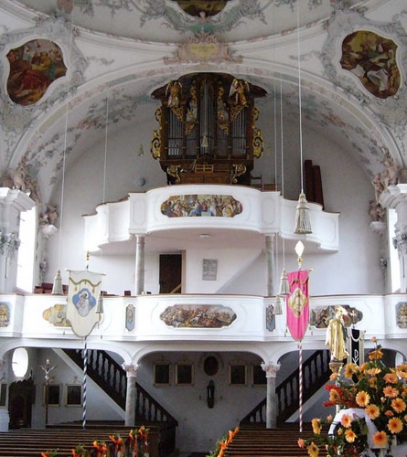


Gabelbach nr Augsburg

Marx Günzer 1609
State of preservation:
In 1609 Marx Günzer built an instrument with nine manual and one pedal stop for Augsburg Barfüßerkirche. In 1708 Anton Berger of Augsburg had to build new bellows, he also added the Subbaß, in 1735 Johann Cronthaler of Kaufbeuren probably replaced Quinte 3’ by Gamba 8’.
For the bicentennary of the peace of Augsburg in 1755 a new organ for the Barfüßerkirche was planned, so Günzer's organ of 1609 was sold to Gabelbach where it was placed in the upper gallery in 1758. Whether Johann Andreas Stein was involved is unclear, since he was busy with building the new instrument. The price of 250 Gulden for the old organ contributed to the more than 10.000 Gulden for the Stein instrument.
In 1858 and 1874 Anselm Roschmann of Günzburg retuned the organ from the old cornett pitch to chamber pitch, added the missing tones of the long octave,, built a detached console viewing the altar, and covered part of the windchest to install a new Salicional 8’, and a Flöte 4’ and Mixtur 3f. of baroque pipes, replacing the original Mixtur 6f., Cimbel 2f. and Hörnle 2f. and moving Posaune 8’ to the pedal. Since these enlargements strained the capacity of the organ case a slow decay began which made the instrument unplayable in the early 20th century. Agaainst frequent demands of complete removal it was saved by a statement by Joseph Wörsching who had assumed a major part of the instrument to be by Johann Andreas Stein and demanded a preservation of this monument of the Silbermann-Stein tradition. So in 1934 Dreher repaired the instrument after Wörsching's plans, The old substance still present was preserved apart from the remaining Posaune, a second manual added for the completion of the assumed baroque character, easily working by pneumatic action, combining Günzer's slider chest with Barler levers.
When about 2000 the parish decided for a thorough restoration our institute made a documentation with diagnosis of materials. Despite the numerous repairs case, wind chest, about 50 % of pipes and the bellows of 1708 are still present. Further research of records added the original specification and important details about Günzer's work. The key action could be reconstructed following traces of the stop action and the remains of the tracker action, including the action for the stop Vogelgeschrei which was discovered under the wind chest.
Specification:
I/P, 9+2; manual C, D, E, F, G, A, B-c3; pedal C, D, E, F, G, A, B-b° (short octaves)
M:
Principal 8’
Posaune 8’
Cimbel 2f.
Hörnle 2f.
Mixtur 4-6f.
Superoktave 2’
Quinte 3’
Oktave 4’
Copel 8’
P:
Subbaß 16’ (Anton Berger 1708)
Violonbaß 16’ (18th c.)
Vogelgeschrei, Pauken, Tremulant
© Greifenberger Institut für Musikinstrumentenkunde | info@greifenberger-institut.de



